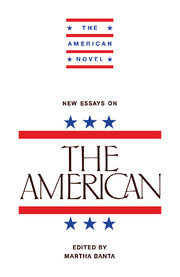4 - Gender and Value in The American
Published online by Cambridge University Press: 06 July 2010
Summary
READERS of The American have always found fault with a plot resolution that leaves Christopher Newman unmarried and Claire de Cintré in a convent. Of course, readers of Henry James have always had to accommodate themselves to endings marked by renunciation. As a colleague of mine once put it, “I have never read a James novel that I did not want to hurl across the room when I finished.” But The American presents a different case from that of, say, The Portrait of a Lady or The Ambassadors, where the reader's frustration and disappointment are, so to speak, fully earned. For as James himself conceded, in the preface he wrote for the heavily revised New York Edition of 1907, the plot of The American is genuinely flawed.
Whereas in 1877 James had defended The American's realism, roundly denouncing those who demanded a “prettier ending” as people “who don't really know the world and who don't measure the merit of a novel by its correspondence to the same,” in 1907 he frankly confesses that the novel's plot is an “affront to verisimilitude.” The Bellegardes “would positively have jumped,” he remarks, at the opportunity to “haul” Newman and “his fortune into their boat” (AN, 36). Since the novel cannot be defended as realistic, James proceeds to treat it as a romance. He thus seizes the opportunity of having erred as a young realist to deliver a definition of the romance that has become a critical chestnut.
- Type
- Chapter
- Information
- New Essays on The American , pp. 99 - 130Publisher: Cambridge University PressPrint publication year: 1987
- 11
- Cited by



